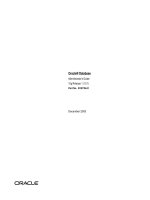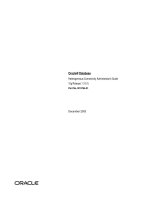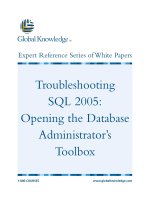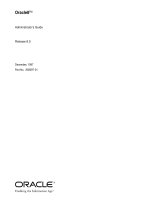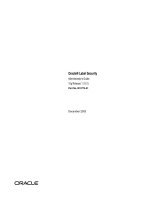Oracle9i Database Administrator’s Guide potx
Bạn đang xem bản rút gọn của tài liệu. Xem và tải ngay bản đầy đủ của tài liệu tại đây (6.31 MB, 980 trang )
Oracle9
i
Database Administrator’s Guide
Release 1 (9.0.1)
June 2001
Part No. A90117-01
Oracle9i Database Administrator’s Guide, Release 1 (9.0.1)
Part No. A90117-01
Copyright © 2001, Oracle Corporation. All rights reserved.
Primary Author: Ruth Baylis
Contributing Authors: Kathy Rich, Joyce Fee
Graphic Designer: Valarie Moore
Contributors: Lance Ashdown, Mark Bauer, Allen Brumm, Michele Cyran, Mary Ann Davidson,
Harvey Eneman, Amit Ganesh, Carolyn Gray, Wei Huang, Robert Jenkins, Mark Kennedy, Jonathan
Klein, Sushil Kumar, Bill Lee, Nina Lewis, Phil Locke, Yunrui Li, Diana Lorentz, Sujatha Muthulingam,
Gary Ngai, Lois Price, Ananth Raghavan, Ann Rhee, John Russell, Rajiv Sinha, Vinay Srihari, Jags
Srinivasan, Anh-Tuan Tran, Deborah Steiner, Janet Stern, Michael Stewart, Ashwini Surpur, Alex
Tsukerman, Kothanda Umamageswaran, Randy Urbano, Steven Wertheimer, Daniel Wong
The Programs (which include both the software and documentation) contain proprietary information of
Oracle Corporation; they are provided under a license agreement containing restrictions on use and
disclosure and are also protected by copyright, patent, and other intellectual and industrial property
laws. Reverse engineering, disassembly, or decompilation of the Programs is prohibited.
The information contained in this document is subject to change without notice. If you find any problems
in the documentation, please report them to us in writing. Oracle Corporation does not warrant that this
document is error free. Except as may be expressly permitted in your license agreement for these
Programs, no part of these Programs may be reproduced or transmitted in any form or by any means,
electronic or mechanical, for any purpose, without the express written permission of Oracle Corporation.
If the Programs are delivered to the U.S. Government or anyone licensing or using the programs on
behalf of the U.S. Government, the following notice is applicable:
Restricted Rights Notice Programs delivered subject to the DOD FAR Supplement are "commercial
computer software" and use, duplication, and disclosure of the Programs, including documentation,
shall be subject to the licensing restrictions set forth in the applicable Oracle license agreement.
Otherwise, Programs delivered subject to the Federal Acquisition Regulations are "restricted computer
software" and use, duplication, and disclosure of the Programs shall be subject to the restrictions in FAR
52.227-19, Commercial Computer Software - Restricted Rights (June, 1987). Oracle Corporation, 500
Oracle Parkway, Redwood City, CA 94065.
The Programs are not intended for use in any nuclear, aviation, mass transit, medical, or other inherently
dangerous applications. It shall be the licensee's responsibility to take all appropriate fail-safe, backup,
redundancy, and other measures to ensure the safe use of such applications if the Programs are used for
such purposes, and Oracle Corporation disclaims liability for any damages caused by such use of the
Programs.
Oracle is a registered trademark, and LogMiner, Oracle Call Interface, Oracle Database Configuration
Assistant, Oracle Enterprise Manager, Oracle Label Security, Real Application Clusters, Oracle OLAP
Services, Oracle Spatial, Oracle Text, PL/SQL, SQL*Plus are trademarks or registered trademarks of
Oracle Corporation. Other names may be trademarks of their respective owners.
iii
Contents
Send Us Your Comments xxix
Preface xxxi
What’s New in Oracle9
i
? xliii
Part I Basic Database Administration
1 The Oracle Database Administrator
Types of Oracle Users 1-2
Database Administrators 1-2
Security Officers 1-3
Network Administrators 1-3
Application Developers 1-3
Application Administrators 1-4
Database Users 1-4
Tasks of a Database Administrator 1-4
Task 1: Evaluate the Database Server Hardware 1-5
Task 2: Install the Oracle Software 1-5
Task 3: Plan the Database 1-5
Task 4: Create and Open the Database 1-6
Task 5: Back Up the Database 1-7
Task 6: Enroll System Users 1-7
Task 7: Implement the Database Design 1-7
iv
Task 8: Back Up the Fully Functional Database 1-7
Task 9: Tune Database Performance 1-8
Identifying Your Oracle Database Software Release 1-8
Release Number Format 1-8
Checking Your Current Release Number 1-9
Database Administrator Security and Privileges 1-9
The Database Administrator’s Operating System Account 1-10
Database Administrator Usernames 1-10
Database Administrator Authentication 1-12
Administrative Privileges 1-12
Selecting an Authentication Method 1-14
Using Operating System (OS) Authentication 1-16
Using Password File Authentication 1-17
Password File Administration 1-18
Using ORAPWD 1-19
Setting REMOTE_LOGIN_ PASSWORDFILE 1-20
Adding Users to a Password File 1-21
Maintaining a Password File 1-23
Database Administrator Utilities 1-24
SQL*Loader 1-24
Export and Import 1-24
2 Creating an Oracle Database
Considerations Before Creating a Database 2-2
Planning for Database Creation 2-2
Meeting Creation Prerequisites 2-4
Deciding How to Create an Oracle Database 2-4
The Oracle Database Configuration Assistant 2-5
Advantages of Using the Oracle Database Configuration Assistant 2-6
Creating a Database 2-6
Configuring Database Options 2-10
Deleting a Database 2-10
Managing Templates 2-10
Manually Creating an Oracle Database 2-11
Step 1: Decide on Your Instance Identifier (SID) 2-12
v
Step 2: Establish the Database Administrator Authentication Method 2-12
Step 3: Create the Initialization Parameter File 2-13
Step 4: Connect to the Instance 2-15
Step 5: Start the Instance 2-15
Step 6: Issue the CREATE DATABASE Statement 2-16
Step 7: Create Additional Tablespaces 2-18
Step 8: Run Scripts to Build Data Dictionary Views 2-19
Step 9: Run Scripts to Install Additional Options (Optional) 2-19
Step 10: Create a Server Parameter File (Recommended) 2-19
Step 11: Back Up the Database 2-20
Oracle9i Features that Simplify Database Creation and Management 2-20
Creating an Undo Tablespace 2-20
Creating a Default Temporary Tablespace 2-21
Using Oracle-Managed Files 2-22
Setting and Managing the Time Zone 2-23
Troubleshooting Database Creation 2-24
Dropping a Database 2-24
Considerations After Creating a Database 2-24
Some Security Considerations 2-25
Installing Oracle’s Sample Schemas 2-26
Initialization Parameters and Database Creation 2-28
Determining the Global Database Name 2-28
Specifying Control Files 2-29
Specifying Database Block Sizes 2-30
Setting Initialization Parameters that Affect the Size of the SGA 2-31
Specifying the Maximum Number of Processes 2-34
Specifying the Method of Undo Space Management 2-34
Setting License Parameters 2-35
Managing Initialization Parameters Using a Server Parameter File 2-36
What is a Server Parameter File? 2-37
Migrating to a Server Parameter File 2-38
Creating a Server Parameter File 2-38
The SPFILE Initialization Parameter 2-39
Using ALTER SYSTEM to Change Initialization Parameter Values 2-40
Exporting the Server Parameter File 2-42
vi
Errors and Recovery for the Server Parameter File 2-43
Viewing Parameters Settings 2-43
3 Using Oracle-Managed Files
What are Oracle-Managed Files? 3-2
Who Can Use Oracle-Managed Files? 3-2
Benefits of Using Oracle-Managed Files 3-3
Oracle-Managed Files and Existing Functionality 3-4
Enabling the Creation and Use of Oracle-Managed Files 3-4
Setting the DB_CREATE_FILE_DEST Initialization Parameter 3-5
Setting the DB_CREATE_ONLINE_LOG_DEST_n Initialization Parameter 3-6
Creating Oracle-Managed Files 3-6
How Oracle-Managed Files are Named 3-7
Creating Oracle-Managed Files at Database Creation 3-8
Creating Datafiles for Tablespaces 3-13
Creating Tempfiles for Temporary Tablespaces 3-16
Creating Control Files 3-17
Creating Online Redo Log Files 3-19
Behavior of Oracle-Managed Files 3-20
Dropping Datafiles and Tempfiles 3-21
Dropping Online Redo Log Files 3-21
Renaming Files 3-21
Managing Standby Databases 3-22
Scenarios for Using Oracle-Managed Files 3-22
Scenario 1: Create and Manage a Database with Multiplexed Online Redo Logs 3-22
Scenario 2: Add Oracle-Managed Files to an Existing Database 3-27
4 Starting Up and Shutting Down
Starting Up a Database 4-2
Options for Starting Up a Database 4-2
Preparing to Start an Instance 4-3
Using SQL*Plus to Start Up a Database 4-3
Starting an Instance: Scenarios 4-5
Altering Database Availability 4-9
Mounting a Database to an Instance 4-9
vii
Opening a Closed Database 4-9
Opening a Database in Read-Only Mode 4-10
Restricting Access to an Open Database 4-10
Shutting Down a Database 4-11
Shutting Down with the NORMAL Option 4-11
Shutting Down with the IMMEDIATE Option 4-12
Shutting Down with the TRANSACTIONAL Option 4-12
Shutting Down with the ABORT Option 4-13
Quiescing a Database 4-13
Placing a Database into a Quiesced State 4-14
Restoring the System to Normal Operation 4-16
Viewing the Quiesce State of an Instance 4-16
Suspending and Resuming a Database 4-16
Part II Oracle Server Processes and Storage Structure
5 Managing Oracle Processes
Server Processes 5-2
Dedicated Server Processes 5-2
Shared Server Processes 5-3
Configuring Oracle for the Shared Server 5-5
Initialization Parameters for Shared Server 5-5
Setting the Initial Number of Dispatchers (DISPATCHERS) 5-6
Setting the Initial Number of Shared Servers (SHARED_SERVERS) 5-8
Modifying Dispatcher and Server Processes 5-8
Monitoring Shared Server 5-11
About Oracle Background Processes 5-11
Monitoring the Processes of an Oracle Instance 5-14
Process and Session Views 5-14
Monitoring Locks 5-15
Trace Files and the Alert File 5-15
Managing Processes for Parallel Execution 5-18
Managing the Parallel Execution Servers 5-18
Altering Parallel Execution for a Session 5-19
Managing Processes for External Procedures 5-20
viii
Setting up an Environment for Calling External Procedures 5-21
Example of tnsnames.ora Entry for External Procedure Listener 5-22
Example of listener.ora Entry for External Procedures 5-22
Terminating Sessions 5-22
Identifying Which Session to Terminate 5-23
Terminating an Active Session 5-24
Terminating an Inactive Session 5-24
6 Managing Control Files
What Is a Control File? 6-2
Guidelines for Control Files 6-2
Provide Filenames for the Control Files 6-2
Multiplex Control Files on Different Disks 6-3
Place Control Files Appropriately 6-3
Back Up Control Files 6-3
Manage the Size of Control Files 6-4
Creating Control Files 6-4
Creating Initial Control Files 6-4
Creating Additional Copies, Renaming, and Relocating Control Files 6-5
Creating New Control Files 6-5
Troubleshooting After Creating Control Files 6-9
Checking for Missing or Extra Files 6-9
Handling Errors During CREATE CONTROLFILE 6-10
Backing Up Control Files 6-10
Recovering a Control File Using a Current Copy 6-10
Recovering from Control File Corruption Using a Control File Copy 6-10
Recovering from Permanent Media Failure Using a Control File Copy 6-11
Dropping Control Files 6-11
Displaying Control File Information 6-12
7 Managing the Online Redo Log
What Is the Online Redo Log? 7-2
Redo Threads 7-2
Online Redo Log Contents 7-2
How Oracle Writes to the Online Redo Log 7-3
ix
Planning the Online Redo Log 7-5
Multiplexing Online Redo Log Files 7-5
Placing Online Redo Log Members on Different Disks 7-9
Setting the Size of Online Redo Log Members 7-9
Choosing the Number of Online Redo Log Files 7-10
Controlling Archive Lag 7-10
Creating Online Redo Log Groups and Members 7-12
Creating Online Redo Log Groups 7-13
Creating Online Redo Log Members 7-13
Relocating and Renaming Online Redo Log Members 7-14
Dropping Online Redo Log Groups and Members 7-16
Dropping Log Groups 7-16
Dropping Online Redo Log Members 7-17
Forcing Log Switches 7-18
Verifying Blocks in Redo Log Files 7-18
Clearing an Online Redo Log File 7-19
Viewing Online Redo Log Information 7-20
8 Managing Archived Redo Logs
What Is the Archived Redo Log? 8-2
Choosing Between NOARCHIVELOG and ARCHIVELOG Mode 8-2
Running a Database in NOARCHIVELOG Mode 8-2
Running a Database in ARCHIVELOG Mode 8-3
Controlling the Archiving Mode 8-4
Setting the Initial Database Archiving Mode 8-5
Changing the Database Archiving Mode 8-5
Enabling Automatic Archiving 8-6
Disabling Automatic Archiving 8-8
Performing Manual Archiving 8-9
Specifying the Archive Destination 8-9
Specifying Archive Destinations 8-9
Understanding Archive Destination Status 8-12
Specifying the Mode of Log Transmission 8-13
Normal Transmission Mode 8-14
Standby Transmission Mode 8-14
x
Managing Archive Destination Failure 8-15
Specifying the Minimum Number of Successful Destinations 8-16
Re-Archiving to a Failed Destination 8-18
Tuning Archive Performance by Specifying Multiple ARCn Processes 8-19
Controlling Trace Output Generated by the Archivelog Process 8-21
Viewing Information About the Archived Redo Log 8-22
Fixed Views 8-23
The ARCHIVE LOG LIST Command 8-24
9 Using LogMiner to Analyze Redo Log Files
Understanding the Value of Analyzing Redo Log Files 9-2
Things to Know Before You Begin 9-2
Redo Log Files 9-3
Dictionary Options 9-4
Tracking of DDL Statements 9-5
Storage Management 9-6
Extracting Data Values from Redo Log Files 9-6
LogMiner Restrictions 9-7
LogMiner Views 9-7
Using LogMiner 9-8
Extracting a Dictionary 9-9
Specifying Redo Log Files for Analysis 9-12
Starting LogMiner 9-13
Analyzing Output from V$LOGMNR_CONTENTS 9-17
Using LogMiner to Perform Object-Level Recovery 9-18
Ending a LogMiner Session 9-18
Example Uses of LogMiner 9-19
Example: Tracking Changes Made By a Specific User 9-19
Example: Calculating Table Access Statistics 9-21
10 Managing Job Queues
Enabling Processes Used for Executing Jobs 10-2
Managing Job Queues 10-3
The DBMS_JOB Package 10-3
Submitting a Job to the Job Queue 10-4
xi
How Jobs Execute 10-9
Removing a Job from the Job Queue 10-10
Altering a Job 10-10
Broken Jobs 10-12
Forcing a Job to Execute 10-13
Terminating a Job 10-13
Viewing Job Queue Information 10-14
Displaying Information About a Job 10-14
Displaying Information About Running Jobs 10-14
11 Managing Tablespaces
Guidelines for Managing Tablespaces 11-2
Use Multiple Tablespaces 11-2
Specify Tablespace Default Storage Parameters 11-3
Assign Tablespace Quotas to Users 11-3
Creating Tablespaces 11-4
Locally Managed Tablespaces 11-5
Dictionary-Managed Tablespaces 11-9
Temporary Tablespaces 11-11
Managing Tablespace Allocation 11-14
Storage Parameters in Locally Managed Tablespaces 11-14
Storage Parameters for Dictionary-Managed Tablespaces 11-15
Coalescing Free Space in Dictionary-Managed Tablespaces 11-16
Altering Tablespace Availability 11-19
Taking Tablespaces Offline 11-19
Bringing Tablespaces Online 11-21
Altering the Availability of Datafiles or Tempfiles 11-21
Using Read-Only Tablespaces 11-22
Making a Tablespace Read-Only 11-23
Making a Read-Only Tablespace Writable 11-25
Creating a Read-Only Tablespace on a WORM Device 11-25
Delaying the Opening of Datafiles in Read Only Tablespaces 11-26
Dropping Tablespaces 11-27
Troubleshooting Tablespace Problems with DBMS_SPACE_ADMIN 11-28
Scenario 1: Fixing Bitmap When Allocated Blocks are Marked Free (No Overlap) 11-29
xii
Scenario 2: Dropping a Corrupted Segment 11-30
Scenario 3: Fixing Bitmap Where Overlap is Reported 11-30
Scenario 4: Correcting Media Corruption of Bitmap Blocks 11-30
Scenario 5: Migrating from a Dictionary-Managed to a Locally Managed Tablespace . 11-31
Transporting Tablespaces Between Databases 11-31
Introduction to Transportable Tablespaces 11-32
Limitations 11-33
Compatibility Considerations for Transportable Tablespaces 11-33
Transporting Tablespaces Between Databases: A Procedure 11-34
Object Behaviors 11-40
Using Transportable Tablespaces 11-42
Viewing Tablespace Information 11-46
Listing Tablespaces and Default Storage Parameters: Example 11-47
Listing the Datafiles and Associated Tablespaces of a Database: Example 11-48
Displaying Statistics for Free Space (Extents) of Each Tablespace: Example 11-48
12 Managing Datafiles
Guidelines for Managing Datafiles 12-2
Determine the Number of Datafiles 12-2
Determine the Size of Datafiles 12-4
Place Datafiles Appropriately 12-4
Store Datafiles Separate from Redo Log Files 12-4
Creating Datafiles and Adding Datafiles to a Tablespace 12-5
Changing a Datafile’s Size 12-6
Enabling and Disabling Automatic Extension for a Datafile 12-6
Manually Resizing a Datafile 12-7
Altering Datafile Availability 12-8
Bringing Datafiles Online or Taking Offline in ARCHIVELOG Mode 12-9
Taking Datafiles Offline in NOARCHIVELOG Mode 12-9
Altering the Availability of All Datafiles or Tempfiles in a Tablespace 12-9
Renaming and Relocating Datafiles 12-10
Renaming and Relocating Datafiles for a Single Tablespace 12-11
Renaming and Relocating Datafiles for Multiple Tablespaces 12-13
Verifying Data Blocks in Datafiles 12-14
Viewing Datafile Information 12-14
xiii
13 Managing Undo Space
What is Undo? 13-2
Specifying the Mode for Undo Space Management 13-3
Starting an Instance in Automatic Undo Management Mode 13-3
Starting an Instance in Manual Undo Management Mode 13-4
Managing Undo Tablespaces 13-5
Creating an Undo Tablespace 13-6
Altering an Undo Tablespace 13-7
Dropping an Undo Tablespace 13-7
Switching Undo Tablespaces 13-8
Establishing User Quotas for Undo Space 13-9
Setting the Retention Period for Undo Information 13-9
Viewing Information About Undo Space 13-11
Managing Rollback Segments 13-13
Guidelines for Managing Rollback Segments 13-13
Creating Rollback Segments 13-18
Altering Rollback Segments 13-21
Explicitly Assigning a Transaction to a Rollback Segment 13-24
Dropping Rollback Segments 13-25
Viewing Rollback Segment Information 13-25
Part III Schema Objects
14 Managing Space for Schema Objects
Managing Space in Data Blocks 14-2
Specifying the PCTFREE Parameter 14-2
Specifying the PCTUSED Parameter 14-5
Selecting Associated PCTUSED and PCTFREE Values 14-7
Specifying the Transaction Entry Parameters: INITRANS and MAXTRANS 14-8
Setting Storage Parameters 14-9
Identifying the Storage Parameters 14-9
Setting Default Storage Parameters for Segments in a Tablespace 14-13
Setting Storage Parameters for Data Segments 14-13
Setting Storage Parameters for Index Segments 14-13
xiv
Setting Storage Parameters for LOBs, Varrays, and Nested Tables 14-14
Changing Values for Storage Parameters 14-14
Understanding Precedence in Storage Parameters 14-14
Example of How Storage Parameters Effect Space Allocation 14-15
Managing Resumable Space Allocation 14-16
Resumable Space Allocation Overview 14-17
Enabling and Disabling Resumable Space Allocation 14-21
Detecting Suspended Statements 14-22
Resumable Space Allocation Example: Registering an AFTER SUSPEND Trigger 14-24
Deallocating Space 14-26
Viewing the High Water Mark 14-27
Issuing Space Deallocation Statements 14-27
Examples of Deallocating Space 14-28
Understanding Space Use of Datatypes 14-31
15 Managing Tables
Guidelines for Managing Tables 15-2
Design Tables Before Creating Them 15-2
Specify How Data Block Space Is to Be Used 15-2
Specify the Location of Each Table 15-3
Consider Parallelizing Table Creation 15-3
Consider Using NOLOGGING When Creating Tables 15-4
Estimate Table Size and Set Storage Parameters 15-4
Plan for Large Tables 15-5
Table Restrictions 15-6
Creating Tables 15-6
Creating a Table 15-6
Creating a Temporary Table 15-7
Parallelizing Table Creation 15-8
Automatically Collecting Statistics on Tables 15-9
Altering Tables 15-9
Moving a Table to a New Segment or Tablespace 15-12
Manually Allocating Storage for a Table 15-12
Dropping Columns 15-12
Redefining Tables Online 15-14
xv
Steps for Online Redefinition of Tables 15-15
Intermediate Synchronization 15-17
Abort and Cleanup After Errors 15-17
Example of Online Table Redefinition 15-17
Restrictions 15-18
Dropping Tables 15-19
Managing Index-Organized Tables 15-20
What are Index-Organized Tables 15-21
Creating Index-Organized Tables 15-22
Maintaining Index-Organized Tables 15-26
Analyzing Index-Organized Tables 15-28
Using the ORDER BY Clause with Index-Organized Tables 15-29
Converting Index-Organized Tables to Regular Tables 15-29
Managing External Tables 15-30
Creating External Tables 15-31
Altering External Tables 15-34
Dropping External Tables 15-35
System and Object Privileges for External Tables 15-35
Viewing Information About Tables 15-35
16 Managing Indexes
Guidelines for Managing Indexes 16-2
Create Indexes After Inserting Table Data 16-3
Index the Correct Tables and Columns 16-3
Order Index Columns for Performance 16-5
Limit the Number of Indexes for Each Table 16-5
Drop Indexes That Are No Longer Required 16-5
Specify Index Block Space Use 16-5
Estimate Index Size and Set Storage Parameters 16-6
Specify the Tablespace for Each Index 16-6
Consider Parallelizing Index Creation 16-7
Consider Creating Indexes with NOLOGGING 16-7
Consider Costs and Benefits of Coalescing or Rebuilding Indexes 16-8
Consider Cost Before Disabling or Dropping Constraints 16-9
Creating Indexes 16-9
xvi
Creating an Index Explicitly 16-10
Creating a Unique Index Explicitly 16-11
Creating an Index Associated with a Constraint 16-11
Collecting Incidental Statistics when Creating an Index 16-13
Creating a Large Index 16-13
Creating an Index Online 16-13
Creating a Function-Based Index 16-14
Creating a Key-Compressed Index 16-18
Altering Indexes 16-19
Altering Storage Characteristics of an Index 16-20
Rebuilding an Existing Index 16-20
Monitoring Index Usage 16-21
Monitoring Space Use of Indexes 16-21
Dropping Indexes 16-22
Viewing Index Information 16-23
17 Managing Partitioned Tables and Indexes
What Are Partitioned Tables and Indexes? 17-2
Partitioning Methods 17-3
When to Use the Range Partitioning Method 17-4
When to Use the Hash Partitioning Method 17-5
When to Use the List Partitioning Method 17-5
When to Use the Composite Partitioning Method 17-7
Creating Partitioned Tables 17-8
Creating Range-Partitioned Tables 17-9
Creating Hash-Partitioned Tables 17-10
Creating List-Partitioned Tables 17-11
Creating Composite Partitioned Tables 17-12
Creating Partitioned Index-Organized Tables 17-13
Partitioning Restrictions for Multiple Block Sizes 17-15
Maintaining Partitioned Tables 17-16
Updating Global Indexes Automatically 17-19
Adding Partitions 17-20
Coalescing Partitions 17-23
Dropping Partitions 17-24
xvii
Exchanging Partitions 17-27
Merging Partitions 17-29
Modifying Default Attributes 17-32
Modifying Real Attributes of Partitions 17-33
Modifying List Partitions: Adding or Dropping Values 17-34
Moving Partitions 17-36
Rebuilding Index Partitions 17-37
Renaming Partitions 17-39
Splitting Partitions 17-39
Truncating Partitions 17-42
Partitioned Tables and Indexes Examples 17-45
Moving the Time Window in a Historical Table 17-45
Converting a Partition View into a Partitioned Table 17-46
Viewing Information About Partitioned Tables and Indexes 17-47
18 Managing Clusters
Guidelines for Managing Clusters 18-2
Choose Appropriate Tables for the Cluster 18-4
Choose Appropriate Columns for the Cluster Key 18-4
Specify Data Block Space Use 18-5
Specify the Space Required by an Average Cluster Key and Its Associated Rows 18-5
Specify the Location of Each Cluster and Cluster Index Rows 18-6
Estimate Cluster Size and Set Storage Parameters 18-6
Creating Clusters 18-6
Creating Clustered Tables 18-7
Creating Cluster Indexes 18-8
Altering Clusters 18-8
Altering Clustered Tables 18-9
Altering Cluster Indexes 18-10
Dropping Clusters 18-10
Dropping Clustered Tables 18-11
Dropping Cluster Indexes 18-11
Viewing Information About Clusters 18-11
xviii
19 Managing Hash Clusters
When to Use Hash Clusters 19-2
Situations Where Hashing Is Useful 19-3
Situations Where Hashing Is Not Advantageous 19-3
Creating Hash Clusters 19-4
Creating Single-Table Hash Clusters 19-5
Controlling Space Use Within a Hash Cluster 19-5
Estimating Size Required by Hash Clusters 19-8
Altering Hash Clusters 19-9
Dropping Hash Clusters 19-9
Viewing Information About Hash Clusters 19-9
20 Managing Views, Sequences, and Synonyms
Managing Views 20-2
Creating Views 20-2
Updating a Join View 20-5
Altering Views 20-10
Dropping Views 20-10
Replacing Views 20-10
Managing Sequences 20-11
Creating Sequences 20-12
Altering Sequences 20-13
Dropping Sequences 20-13
Managing Synonyms 20-13
Creating Synonyms 20-14
Dropping Synonyms 20-14
Viewing Information About Views, Synonyms, and Sequences 20-15
21 General Management of Schema Objects
Creating Multiple Tables and Views in a Single Operation 21-2
Renaming Schema Objects 21-3
Analyzing Tables, Indexes, and Clusters 21-3
Using Statistics for Tables, Indexes, and Clusters 21-4
Validating Tables, Indexes, Clusters, and Materialized Views 21-9
xix
Listing Chained Rows of Tables and Clusters 21-10
Truncating Tables and Clusters 21-12
Using DELETE 21-12
Using DROP and CREATE 21-13
Using TRUNCATE 21-13
Enabling and Disabling Triggers 21-14
Enabling Triggers 21-16
Disabling Triggers 21-16
Managing Integrity Constraints 21-17
Integrity Constraint States 21-17
Setting Integrity Constraints Upon Definition 21-20
Modifying or Dropping Existing Integrity Constraints 21-21
Deferring Constraint Checks 21-22
Reporting Constraint Exceptions 21-23
Managing Object Dependencies 21-25
Manually Recompiling Views 21-27
Manually Recompiling Procedures and Functions 21-27
Manually Recompiling Packages 21-27
Managing Object Name Resolution 21-28
Changing Storage Parameters for the Data Dictionary 21-28
Structures in the Data Dictionary 21-29
Errors that Require Changing Data Dictionary Storage 21-31
Displaying Information About Schema Objects 21-31
Using PL/SQL Packages to Display Information About Schema Objects 21-31
Using Views to Display Information About Schema Objects 21-33
22 Detecting and Repairing Data Block Corruption
Options for Repairing Data Block Corruption 22-2
About the DBMS_REPAIR Package 22-2
DBMS_REPAIR Procedures 22-2
Limitations and Restrictions 22-3
Using the DBMS_REPAIR Package 22-3
Task 1: Detect and Report Corruptions 22-4
Task 2: Evaluate the Costs and Benefits of Using DBMS_REPAIR 22-5
Task 3: Make Objects Usable 22-7
xx
Task 4: Repair Corruptions and Rebuild Lost Data 22-7
DBMS_REPAIR Examples 22-8
Using ADMIN_TABLES to Build a Repair Table or Orphan Key Table 22-9
Using the CHECK_OBJECT Procedure to Detect Corruption 22-10
Fixing Corrupt Blocks with the FIX_CORRUPT_BLOCKS Procedure 22-12
Finding Index Entries Pointing into Corrupt Data Blocks: DUMP_ORPHAN_KEYS 22-13
Rebuilding Free Lists Using the REBUILD_FREELISTS Procedure 22-13
Enabling or Disabling the Skipping of Corrupt Blocks: SKIP_CORRUPT_BLOCKS 22-14
Part IV Database Security
23 Establishing Security Policies
System Security Policy 23-2
Database User Management 23-2
User Authentication 23-2
Operating System Security 23-3
Data Security Policy 23-3
User Security Policy 23-4
General User Security 23-4
End-User Security 23-6
Administrator Security 23-8
Application Developer Security 23-10
Application Administrator Security 23-12
Password Management Policy 23-12
Account Locking 23-13
Password Aging and Expiration 23-14
Password History 23-15
Password Complexity Verification 23-16
Auditing Policy 23-20
A Security Checklist 23-20
24 Managing Users and Resources
Session and User Licensing 24-2
Concurrent Usage Licensing 24-2
xxi
Named User Limits 24-5
Viewing Licensing Limits and Current Values 24-6
User Authentication Methods 24-7
Database Authentication 24-8
External Authentication 24-9
Global Authentication and Authorization 24-11
Proxy Authentication and Authorization 24-13
Managing Oracle Users 24-16
Creating Users 24-16
Altering Users 24-20
Dropping Users 24-21
Managing Resources with Profiles 24-22
Enabling and Disabling Resource Limits 24-23
Creating Profiles 24-24
Assigning Profiles 24-25
Altering Profiles 24-25
Using Composite Limits 24-25
Dropping Profiles 24-27
Viewing Information About Database Users and Profiles 24-27
Listing All Users and Associated Information 24-29
Listing All Tablespace Quotas 24-29
Listing All Profiles and Assigned Limits 24-30
Viewing Memory Use for Each User Session 24-31
25 Managing User Privileges and Roles
Identifying User Privileges 25-2
System Privileges 25-2
Object Privileges 25-4
Managing User Roles 25-4
Predefined Roles 25-5
Creating a Role 25-7
Specifying the Type of Role Authorization 25-8
Dropping Roles 25-10
Granting User Privileges and Roles 25-11
Granting System Privileges and Roles 25-11
xxii
Granting Object Privileges and Roles 25-12
Granting Privileges on Columns 25-13
Revoking User Privileges and Roles 25-14
Revoking System Privileges and Roles 25-14
Revoking Object Privileges and Roles 25-14
Cascading Effects of Revoking Privileges 25-16
Granting to and Revoking from the User Group PUBLIC 25-17
When Do Grants and Revokes Take Effect? 25-17
The SET ROLE Statement 25-18
Specifying Default Roles 25-18
Restricting the Number of Roles that a User Can Enable 25-19
Granting Roles Using the Operating System or Network 25-19
Using Operating System Role Identification 25-20
Using Operating System Role Management 25-22
Granting and Revoking Roles When OS_ROLES=TRUE 25-22
Enabling and Disabling Roles When OS_ROLES=TRUE 25-22
Using Network Connections with Operating System Role Management 25-22
Viewing Privilege and Role Information 25-23
Listing All System Privilege Grants 25-25
Listing All Role Grants 25-25
Listing Object Privileges Granted to a User 25-25
Listing the Current Privilege Domain of Your Session 25-26
Listing Roles of the Database 25-27
Listing Information About the Privilege Domains of Roles 25-27
26 Auditing Database Use
Guidelines for Auditing 26-2
Decide Whether to Use the Database or Operating System Audit Trail 26-2
Keep Audited Information Manageable 26-2
Guidelines for Auditing Suspicious Database Activity 26-3
Guidelines for Auditing Normal Database Activity 26-4
Managing Audit Trail Information 26-4
What Information is Contained in the Audit Trail? 26-4
Events Audited by Default 26-5
Setting Auditing Options 26-6
xxiii
Turning Off Audit Options 26-10
Enabling and Disabling Database Auditing 26-12
Controlling the Growth and Size of the Audit Trail 26-13
Protecting the Audit Trail 26-15
Fine-Grained Auditing 26-16
Viewing Database Audit Trail Information 26-17
Creating the Audit Trail Views 26-17
Deleting the Audit Trail Views 26-18
Using Audit Trail Views to Investigate Suspicious Activities 26-18
Part V Database Resource Management
27 Using the Database Resource Manager
What Is the Database Resource Manager? 27-2
What Problems Does the Database Resource Manager Address? 27-2
How Does the Database Resource Manager Address These Problems? 27-2
What are the Elements of the Database Resource Manager? 27-3
Understanding Resource Plans 27-4
Administering the Database Resource Manager 27-8
Creating a Simple Resource Plan 27-10
Creating Complex Resource Plans 27-11
Using the Pending Area for Creating Plan Schemas 27-12
Creating Resource Plans 27-14
Creating Resource Consumer Groups 27-16
Specifying Resource Plan Directives 27-17
Managing Resource Consumer Groups 27-20
Assigning an Initial Resource Consumer Group 27-21
Changing Resource Consumer Groups 27-21
Managing the Switch Privilege 27-22
Enabling the Database Resource Manager 27-24
Putting It All Together: Database Resource Manager Examples 27-25
Multilevel Schema Example 27-25
Example of Using Several Resource Allocation Methods 27-27
An Oracle Supplied Plan 27-28
Monitoring and Tuning the Database Resource Manager 27-29
xxiv
Creating the Environment 27-29
Why Is This Necessary to Produce Expected Results? 27-30
Monitoring Results 27-31
Viewing Database Resource Manager Information 27-31
Viewing Consumer Groups Granted to Users or Roles 27-32
Viewing Plan Schema Information 27-33
Viewing Current Consumer Groups for Sessions 27-33
Viewing the Currently Active Plans 27-34
Part VI Distributed Database Management
28 Distributed Database Concepts
Distributed Database Architecture 28-2
Homogenous Distributed Database Systems 28-2
Heterogeneous Distributed Database Systems 28-5
Client/Server Database Architecture 28-6
Database Links 28-8
What Are Database Links? 28-8
What Are Shared Database Links? 28-10
Why Use Database Links? 28-11
Global Database Names in Database Links 28-12
Names for Database Links 28-14
Types of Database Links 28-15
Users of Database Links 28-16
Creation of Database Links: Examples 28-19
Schema Objects and Database Links 28-20
Database Link Restrictions 28-22
Distributed Database Administration 28-23
Site Autonomy 28-23
Distributed Database Security 28-24
Auditing Database Links 28-31
Administration Tools 28-31
Transaction Processing in a Distributed System 28-33
Remote SQL Statements 28-33
Distributed SQL Statements 28-34
xxv
Shared SQL for Remote and Distributed Statements 28-34
Remote Transactions 28-35
Distributed Transactions 28-35
Two-Phase Commit Mechanism 28-35
Database Link Name Resolution 28-36
Schema Object Name Resolution 28-39
Global Name Resolution in Views, Synonyms, and Procedures 28-42
Distributed Database Application Development 28-44
Transparency in a Distributed Database System 28-44
Remote Procedure Calls (RPCs) 28-46
Distributed Query Optimization 28-47
Character Set Support 28-47
Client/Server Environment 28-49
Homogeneous Distributed Environment 28-49
Heterogeneous Distributed Environment 28-50
29 Managing a Distributed Database
Managing Global Names in a Distributed System 29-2
Understanding How Global Database Names Are Formed 29-2
Determining Whether Global Naming Is Enforced 29-3
Viewing a Global Database Name 29-4
Changing the Domain in a Global Database Name 29-4
Changing a Global Database Name: Scenario 29-5
Creating Database Links 29-8
Obtaining Privileges Necessary for Creating Database Links 29-8
Specifying Link Types 29-9
Specifying Link Users 29-11
Using Connection Qualifiers to Specify Service Names Within Link Names 29-13
Creating Shared Database Links 29-14
Determining Whether to Use Shared Database Links 29-14
Creating Shared Database Links 29-15
Configuring Shared Database Links 29-16
Managing Database Links 29-18
Closing Database Links 29-19
Dropping Database Links 29-19
